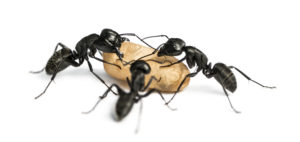Carpenter Ants
Carpenter ants can be a problematic and destructive pest. Like other wood destroying organisms (WDO’s) carpenter ants can leave behind significant damage to wooden structural features and furniture in and around your home. As such, many homeowners are rightfully concerned about the risk that these pests can pose to their property.

In the years that we have worked in the pest industry, we have encountered hundreds of instances of carpenter ant infestation in homes, businesses, and other structures.
In every instance, early detection of these pests plays a critical role in minimizing the frustration and expense of treatment. For this reason, we wanted to create a guide of steps that homeowners can take to better protect their homes from carpenter ants.
So without further ado, here are our Top 5 Tips for keeping carpenter ants OUT!
- Keep your home in good repair
While this is in general good advice for homeowners, it is especially important when it comes to the wood-based features of your home.
Contrary to popular belief, carpenter ants do not consume wood or other cellulosic materials because they lack the necessary digestive bacteria. Instead, carpenter ants excavate wood to form tunnel systems for their nests and to provide access to the home.
Carpenter ants have a preference for unpainted, decaying wood, as it is oftentimes softer and easier to excavate. This leads them to often target parts of the home that have more aged and damaged wood.
These areas are often where the wood receives an unusual amount of moisture. Thus carpenter ants will often nest around skylights, wooden gutters, large appliances such as washing machines, and parts of the home with exterior wood-to-ground contact.
As a homeowner, you should ensure that any of these risk areas are identified and kept in good repair so as to avoid making an easy access avenue for carpenter ants and other pests.
- Look out for swarmers
When a nest becomes too large, it is common for carpenter ants to expand and establish satellite nests. These nests require queens to function, and for this reason, the queen will produce a type of winged, reproductive ants known as swarmers.
Swarmer ants often appear during the late spring and early summer. Their primary task is to mate with swarmers from other colonies, and then establish a new satellite nest. While these nests will not be functional for at least a year, the presence of swarmers around your home indicates that carpenter ants are currently active and will be active in the future.
While seeing swarmers outside your home is not necessarily indicative of an infestation, spotting swarmers indoors is strong evidence that carpenter ants are active in your home.
- Eliminate exploitable food and moisture sources.
As we already said, carpenter ants do not consume wood for sustenance. Carpenter ant workers are efficient and versatile scavengers, and your home can provide them with a plethora of food sources. These ants have a preference for sweet, sugary foods, but will target any dry, stored foods, pet food, garbage, or compost.
Carpenter ants are nocturnal scavengers, so it is rare to spot the workers moving about. By reducing the availability of food and moisture sources, homeowners can avoid attracting carpenter ants and other pests into their home and slow the growth of existing infestations.
- Schedule regular inspections of your home.
One of the most critical steps to keeping your home pest free is ensuring that it is regularly checked over by a licensed pest professional. The fact is, it can be difficult to identify the subtle evidence of pest activity in your home, and oftentimes professional expertise is necessary to diagnose the problem.
While many people tend to approach pest control with a, “Treat when there is a problem” approach, this is often misguided. Many times a great deal of frustration and expense can be avoided by taking the steps to protect your home BEFORE a pest infestation has been established.
- If you are dealing with an active infestation, call in the experts!
In conjunction with the previous point, an active carpenter ant infestation is often best left in the hands of the professionals. Carpenter ant nests are often established in secluded parts of the home. Because of this, many DIY treatments kill only scavenging workers and do nothing to eliminate the larger issue.
Effective carpenter ant treatment requires a multistep approach that typically includes treatment products requiring a license for use. So many times you can resolve your pest problem with a lot less hassle by calling in a pest professional.
But not just any pest professional will do. You need a team that you can trust to resolve your pest problems quickly, safely, and completely!
At Canton Termite and Pest Control, we have decades of experience serving as an industry-leading pest control service based right here in Cherokee County, GA!
We understand that the trust of our customers is a critical part of the treatment process, and due to this we are continuously innovating and improving our treatment methodology to ensure the highest quality of service.
In fact, we are so confident in our ability to rid your home of pests that all of our treatments come backed by 100% Satisfaction Guarantee! So if you aren’t happy with any aspect of your service, you won’t pay a penny! No exceptions, no red tape, just reliable, trustworthy service!
So let today be the beginning of your pest free life, give us a call at 770-479-1598!
By: Tim
